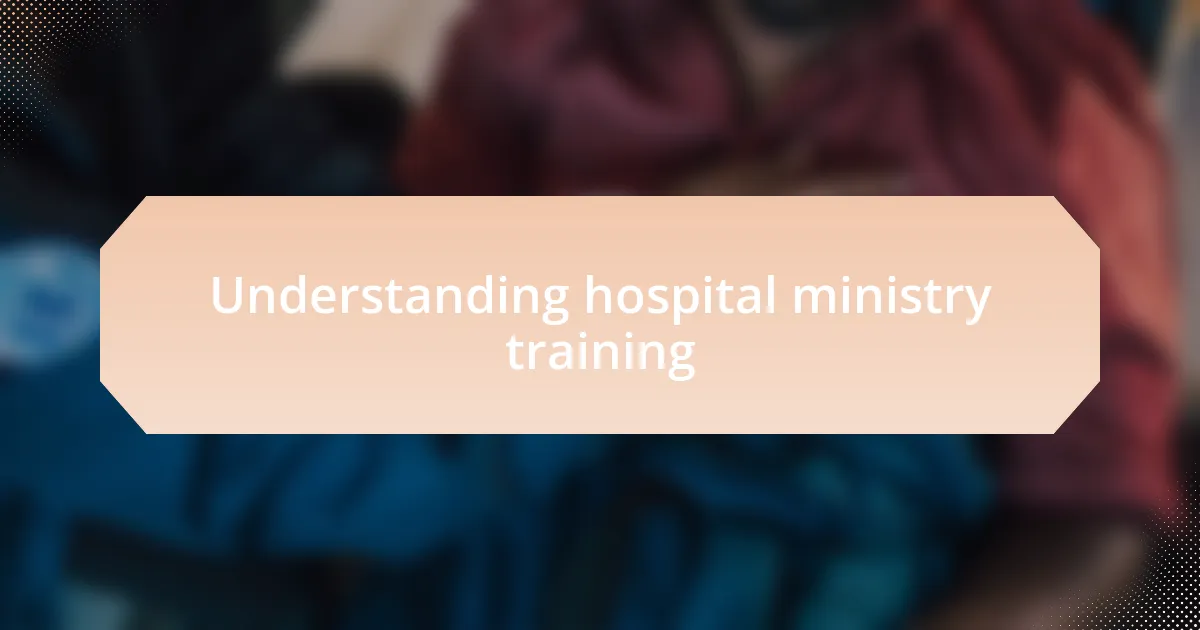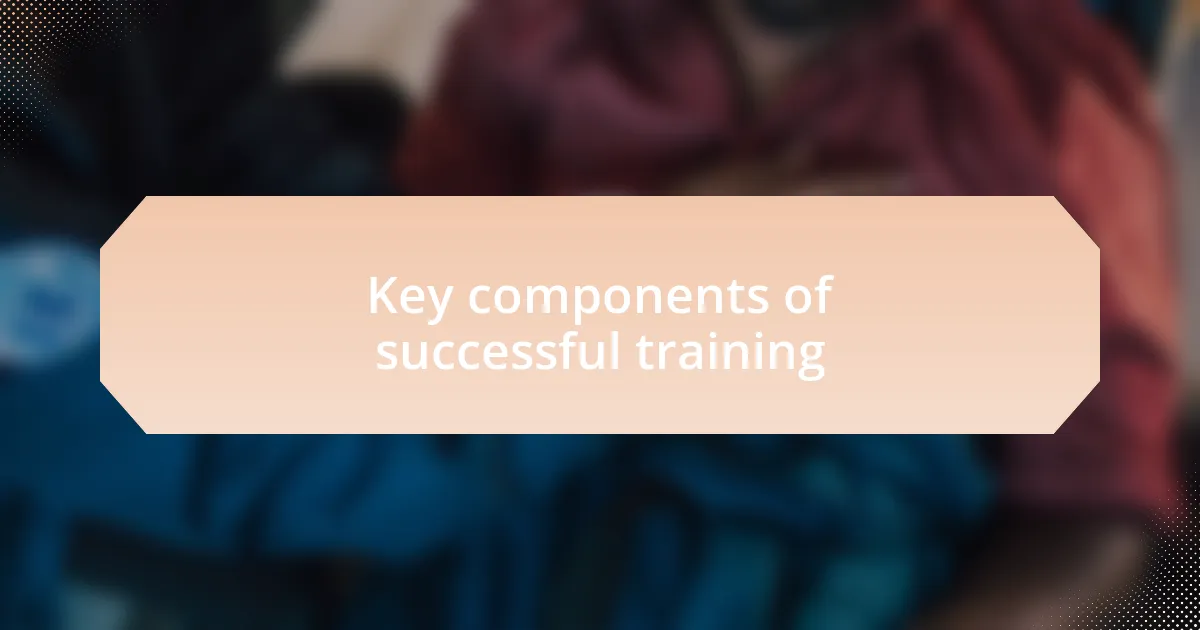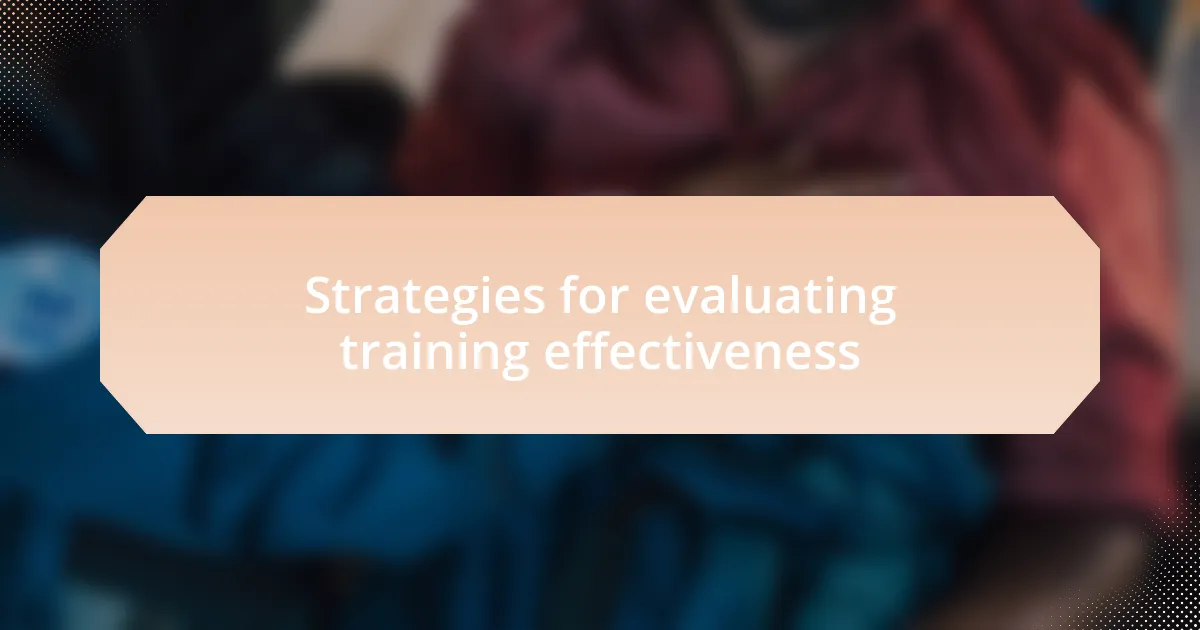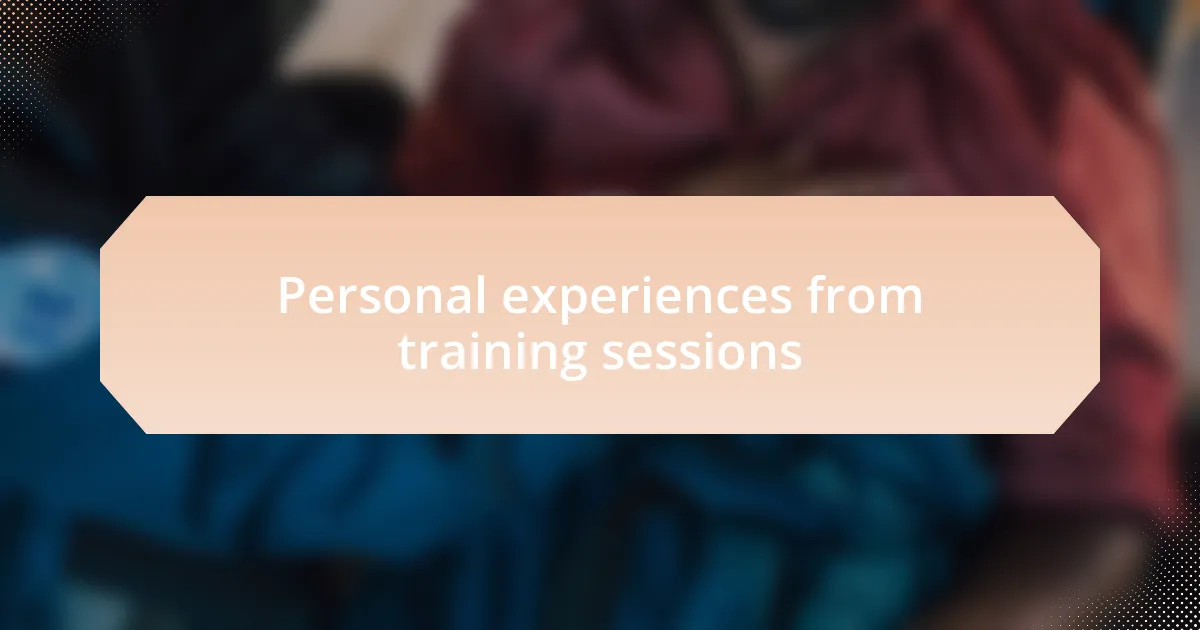Key takeaways:
- Hospital ministry training emphasizes emotional resilience, active listening, and practical skills to support vulnerable patients.
- Effective training fosters a culture of self-care and community among caregivers, enhancing their capacity to serve with compassion.
- Engaging training techniques, such as storytelling and role-playing, help participants connect deeply with the material and each other.
- Evaluating training outcomes through feedback and behavioral observation allows for continuous improvement and demonstrates the training’s impact on caregivers’ practices.

Understanding hospital ministry training
Hospital ministry training is a unique blend of practical skills and deep compassion. I remember my first training session, where an experienced chaplain shared the powerful impact of a simple hug or a few comforting words. It struck me then—how seemingly small gestures could carry such weight in a hospital setting. Are we truly prepared to be a source of hope when someone feels at their most vulnerable?
The structure of hospital ministry training often focuses on emotional resilience and active listening. I’ve found that learning to listen without judgment can be transformative—not just for the patients, but for us as caregivers as well. Each training experience teaches us to navigate the complexities of grief and hope intimately. It really prompts one to ponder: how can we best support those who are facing life’s most challenging moments?
Moreover, practical components of training, like role-playing difficult conversations, prepare us for real-world scenarios we might face. I recall practicing how to deliver difficult news; it was uncomfortable yet necessary. I realized that by simulating these difficult interactions, we arm ourselves with the confidence needed to handle challenging situations when they arise. This training highlights not just the skills learned, but the emotional growth that comes from engaging deeply with our calling in hospital ministry.

Importance of effective training sessions
The significance of effective training sessions in hospital ministry cannot be overstated. I recall a particularly insightful workshop where we delved into the power of presence. Being physically present for someone in crisis—without feeling the need to fill the silence with words—was a lesson that resonated deeply with me. How often do we underestimate the strength of simply being there for others in their moments of need?
When training sessions are executed well, they foster a culture of continuous improvement and support. I remember feeling incredibly empowered after a session focused on self-care techniques for caregivers. It was eye-opening to realize that taking care of myself directly impacts my ability to be present for others. Isn’t it fascinating how a few hours of training can set the foundation for a lifelong commitment to serving with compassion?
Lastly, engaging in effective training sessions cultivates a sense of community among volunteers and chaplains. During one group exercise, we shared our fears and challenges, creating bonds that extended beyond the training room. This collective vulnerability made us stronger as a team. Can there be a greater strength than a united group, equipped with the skills and trust to support one another in the challenging environment of hospital ministry?

Key components of successful training
An essential component of successful training is a clear set of objectives. I once attended a session that had well-defined targets, and it transformed our focus. When we knew what we were aiming for, it felt like embarking on a meaningful journey together, rather than just a series of lectures. Have you ever walked away from a training feeling unsure of what you were supposed to learn? Clarity helps us all stay on the same page.
Another important aspect is interactive participation. I remember a training that incorporated role-playing scenarios. Engaging in simulated conversations with colleagues allowed us to practice our communication skills in real-time. It was not only fun but also gave me confidence to handle difficult conversations later. Have you found that hands-on practice makes you more prepared for real-life situations? It certainly has for me.
Lastly, feedback plays a vital role in enhancing training effectiveness. After one session, I received constructive criticism that highlighted not only my strengths but areas I could improve. At first, it stung a bit, but I realized how valuable that insight was for my growth. How often do we seek out feedback to refine our abilities? Embracing it can be a game changer for anyone looking to excel in their caregiving role.

Techniques for engaging participants
One effective technique for engaging participants is to incorporate storytelling into your training sessions. I vividly recall a workshop where the facilitator shared a personal story about a challenging patient interaction. This approach not only humanized the topic but also allowed me to relate my own experiences to the situation. Have you ever noticed how a good story can draw you in and make the lesson resonate? It’s a powerful tool that can create empathy and deeper understanding among participants.
Utilizing visual aids can also significantly boost engagement during training. In one session, I experienced the impact of infographics and videos that presented data in a relatable manner. Suddenly, complex statistics about healthcare outcomes became tangible and memorable. Have you experienced that ‘aha’ moment when visuals connected the dots for you? It helps participants grasp difficult concepts quickly and keeps the energy in the room alive.
Finally, fostering a safe environment for sharing thoughts and experiences encourages more meaningful discussions. I once facilitated a group that was nervous at first, but after setting ground rules for respectful dialogue, everyone started contributing. The transformation was remarkable—what began as a quiet session turned into a vibrant exchange of ideas. How important is it for you to feel safe when expressing your thoughts? Creating that trust can lead to rich conversations and invaluable learning experiences.

Strategies for evaluating training effectiveness
Evaluating the effectiveness of training sessions is crucial for continuous improvement. One strategy that I’ve found incredibly insightful is collecting feedback immediately after the training. In one instance, I distributed anonymous surveys to participants, which allowed them to share their thoughts candidly. The results were eye-opening—participants highlighted areas of strength and aspects that needed refining, and those insights guided my approach in future sessions.
Another effective method is to observe behavioral changes in participants over time. For example, I noticed that after a particularly impactful training on empathy in patient care, the team began exhibiting more compassion in their interactions. It became evident as they shared stories of patients who felt more understood and cared for. I often reflect on how rewarding it is to witness this transformation. Have you ever experienced a shift in your practice after a training session that left a lasting mark?
Pre- and post-assessments can provide quantifiable data on the training’s impact. In one training, I conducted a short quiz before the session and another afterward, measuring knowledge retention. The improvement was not just in numbers; it was in the confidence the participants displayed in applying what they learned. Did you ever feel that surge of assurance after mastering new information? It’s that feeling of readiness that we strive to instill in our training initiatives.

Personal experiences from training sessions
During one training session focused on communication skills, I vividly remember a moment when a participant shared a deeply personal story about their struggle to connect with patients. It struck a chord with everyone in the room. I could feel the energy shift, as faces turned toward her, and suddenly, we were not just a group of colleagues but a supportive community. That experience reminded me of the power of vulnerability in learning; sometimes, sharing our challenges opens the door for genuine understanding and improvement.
In another session, I experimented with role-playing scenarios to bring training concepts to life. Initially, I was apprehensive about how well it would be received. However, watching participants dive into their roles was exhilarating. I distinctly recall one participant, typically reserved, stepping outside their comfort zone and portraying a doctor handling a difficult conversation with a family member. The room erupted in applause, highlighting that a little encouragement can unleash untapped potential. Have you ever witnessed such a transformation in someone during a workshop?
There was also a training aimed at stress management techniques, where we incorporated mindfulness exercises. I felt a wave of relief wash over me during the session as participants connected with these practices. One individual later expressed how they had started to implement these techniques in their daily routine and noticed a significant reduction in their anxiety levels at work. This kind of feedback gives me hope—it shows that our efforts in training can lead to tangible improvements in well-being. Isn’t it amazing to think about how simple strategies can drastically enhance someone’s experience in a hospital environment?